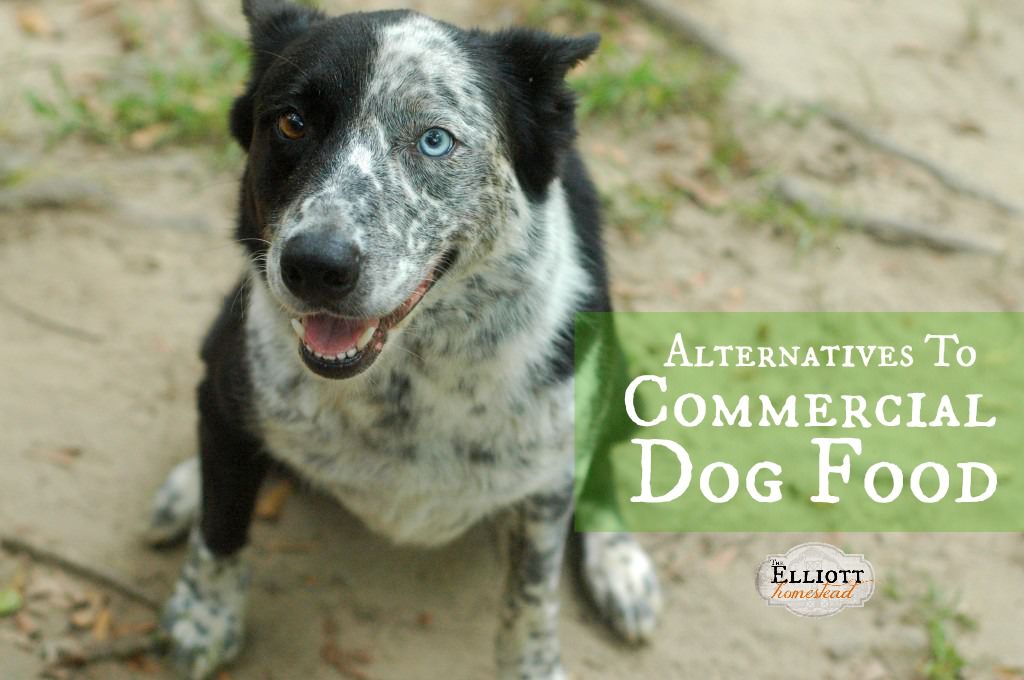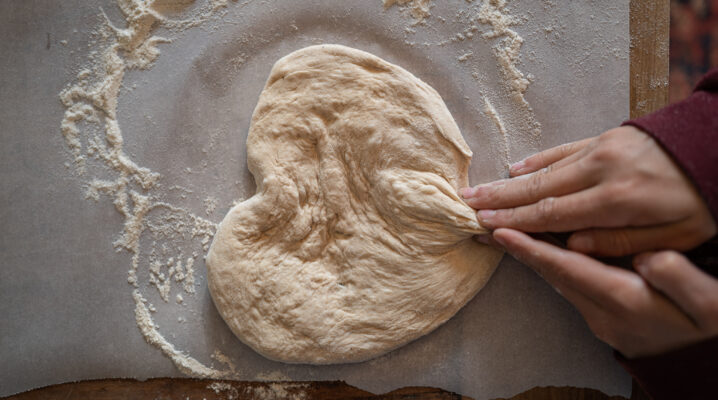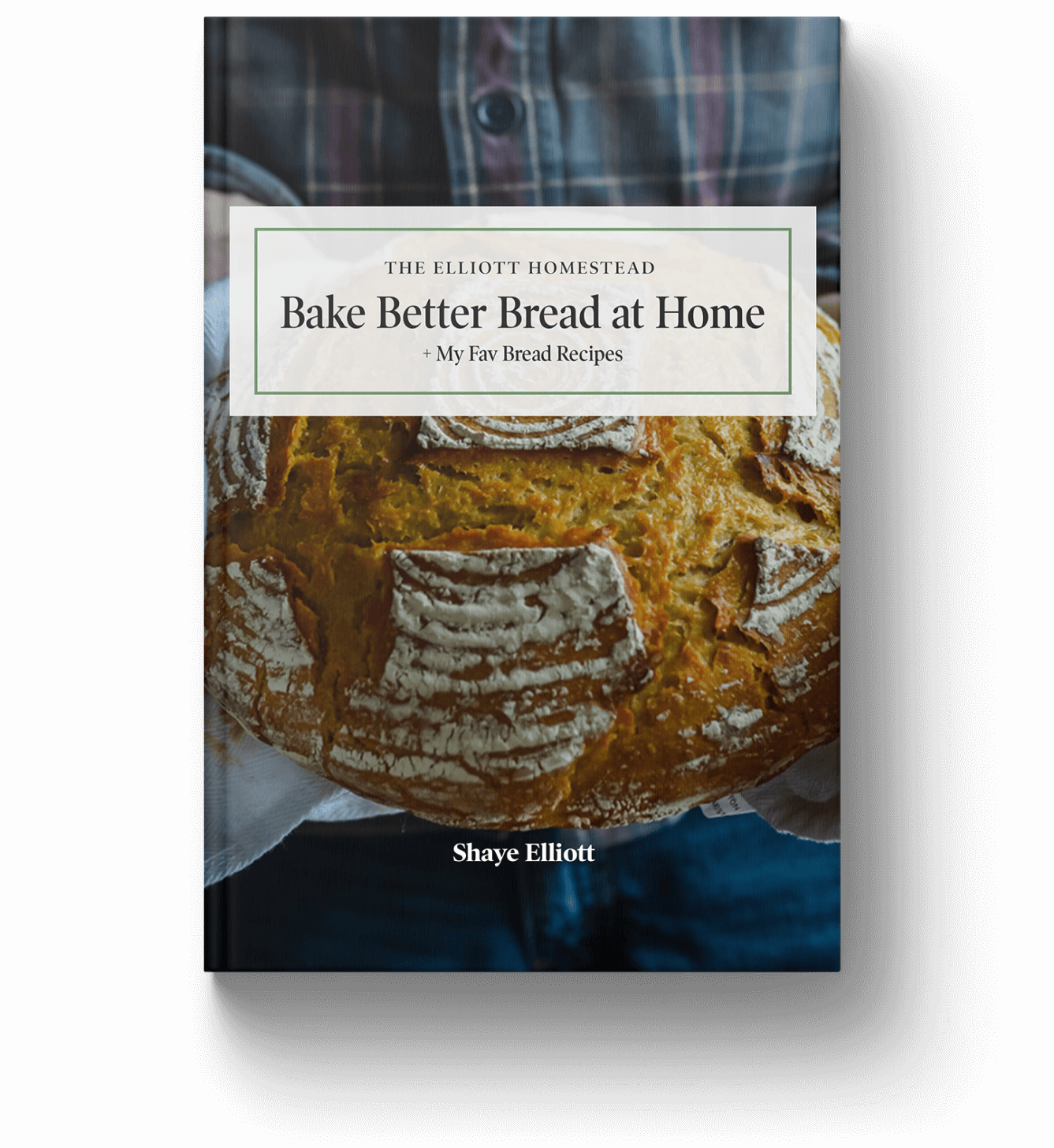I love my Toby turd. One may think that because I have nicknamed him Toby ‘turd' I don't love him, but truth be told, I really do. He's the most loyal pooch in the entire world, faithfully guarding our livestock all day every day.
I'm ashamed then, to say, that Toby Turd was the last animal on our farm we converted to a nutrient-dense, whole-food diet. The cow gets hay and oats. The sheep get hay. The chickens get organic, non-GMO, locally sourced grain and free range all day. The turkey and meat chickens get the same. Even the pigs get organic vegetable scraps from the garden and fresh raw milk.
And yet poor, neglected Toby got the cheapest dog food I could find. You know the kind. The kind that sits on the bottom of the grocery store shelf in a 5o pounds bag for $3.
Fine. That was an exaggeration.
But still. It's sort of the truth.
Last summer, after moving the farm, I kept Toby on his nasty, processed dog food diet for about 4 months. And then I quit.
I quit buying it. I quit giving into the nasty, genetically modified and artificial ingredients that fill up those giant bags. Even our household pets are subject to disease and chronic health problems from bad diets and frankly, I knew better.
Alternatives To Commercial Dog Food
But what exactly IS in those bags? Let's take a peek.
My first search initially lead me to THIS ARTICLE. Yummy. But for me, dead chicken heads and feet aren't the biggest ‘yuck' factor.
What most consumers don’t know is that the pet food industry is an extension of the human food and agriculture industries. Pet food provides a convenient way for slaughterhouse offal, grains considered “unfit for human consumption,” and similar waste products to be turned into profit. This waste includes intestines, udders, heads, hooves, and possibly diseased and cancerous animal parts. Source
I knew it—but I didn't want to admit it to myself. I rarely, if ever, trust the large food industry. I've seen first hand what beef cattle are fed on feed lots (remember? I used to work on one!) and of course it makes perfect sense that the cheap-is-better mentality rules all in this business.
The difference between naturally constituted whole foods and scientifically concocted manufactured pet foods can be seen on the pet food labels with a plethora of synthetic vitamins, amino acids and trace minerals of dubious nutritive value and origin (as from China) deemed essential because of the poor quality of lowest-cost basic ingredients, and because of the destruction/denaturing of essential nutrients due to processing, storage and cooking. Aside from the fact that major pet food companies are still selling predominantly cereal-based cat foods (e.g. combinations of corn meal, corn gluten meal, brewers rice, wheat, and soy flour), as ‘complete and balanced nutrition for all life stages according to AAFCO animal feeding tests' which, for documented health reasons, is unethical, dog and cat foods can include the following non-nutritive additives:
Manufactured pet foods can contain umectants like sugar/sucrose, corn syrup, sorbitol and molasses; antimicrobial preservatives like propionic, sorbic and phosphoric acids, sodium nitrite, sodium and calcium propionate and potassium sorbate; natural coloring agents like iron oxide and caramel, and synthetic coloring agents like coal-tar derived azo-dyes such as Yellow 5, Red 40, Yellow 6, and Blue 2; emulsifying agents used as stabilizers and thickeners, such as seaweed, seed, and microbial gums, gums from trees, and chemically modified plant cellulose like citrus pectin, xanthan and guar gum, and carrageenan; flavor and palatability enhances include ‘natural' flavors, ‘animal digest,' and even MSG (monosodium glutamate); natural fiber like beet pulp, and miscellaneous additives like polyphosphates that help retain natural moisture, condition and texture of manufactured pet foods.
Red 2G food coloring has been identified by the European Food Standards Authority as a carcinogen, and other coal-tar and petrochemical-derived Azo dyes used as food (and beverage) coloring agents are now being re-evaluated.
Gimmicky additions to pet foods include marigold and chicory extract, and touting chicken byproduct meal as a ‘source of chondriotin and glucosamine' in reality means that much of this ingredient is probably of low protein value because it contains a lot of cartilage and bone from the remains of ground up chicken parts not considered fit for human consumption. Source
Our dog is an important, nay, essential part of our homestead. He is irreplaceable. Why on earth would I feed him a product that could bring him to physical sickness?
What the Big Companies Do Right
What I do appreciate about the commercial pet food industry is that they make use of ‘waste' from the human food system. Often utilized are chicken heads, necks, meat scraps, etc. As a frugal homestead, I can appreciate the resourcefulness and utilizing pieces and bits that would otherwise be truly wasted.
When cattle, swine, chickens, lambs, or other animals are slaughtered, lean muscle tissue is trimmed away from the carcass for human consumption, along with the few organs that people like to eat, such as tongues and tripe. Source
GREAT! By all means, utilize the tripe and the tongue. I like this concept. But let's do it right.
What the Big Companies Do Wrong
First, they assume that dogs and cats are mostly vegetarians, pumping their product full of vegetable proteins in the form of soybeans. Just an observation here, but dogs are carnivores. That means they primarily eat meat. Grains are fine in moderation, but must not make up the majority of the diet. That leads to dietary and gut problems—dogs are designed to digest meat!
On top of relying on genetically modified animal protein, the companies also include scraps and by-products that are hazardous, including sick and diseased animals, and bits of the meat that no animal should be eating, such as stillborn animals, infected animals, and uncleaned intestines.
What I Feed As An Alternative
From Dr. Michael W. Fox, B.Vet.Med., Ph.D., D.Sc. M.R.C.V.S.:
Regardless of the spring of 2007 largest ever pet food recall that resulted in the poisoning and deaths of thousands of dogs and cats across North America, my answer to this question, unlike many of my veterinary colleagues, I have come to believe that dogs and cats should not be fed most manufactured pet foods as their main or only source of nutritional sustenance.
I have come to this conclusion because of the dramatic clinical improvement in dogs and cats suffering from a number of chronic, debilitating, and costly health problems once they have been taken off highly processed commercial pet foods and are given naturally formulated, organic whole food diets appropriate for their species, age, physical condition, and activity level.
Scientifically formulated, manufactured pet foods are packed with chemical supplements used to ‘fortify,' i.e. make up for deficiencies in the basic ingredients that are slaughter house and food and beverage industry waste byproducts, and other chemical additives to flavor/taste-enhance, stabilize, preserve, color and ‘texturize' ( appear like meat and gravy rather than a grey mush). According to a CNN News report on July 20, 2007, such supplements that are put into processed foods for human consumption as well as in to pet foods are not subject to any FDA inspection or oversight, and the government has no records as to country of origin of these additives/supplements. Source
That says it all… ‘a naturally formulated, organic whole food diet.' And by that, well, I took it upon myself to interpret it specific for my Toby Turd. For Toby, it means:
– Raw liver
– Chicken heads
– Extra chicken and beef broth
– All meat scraps (both raw and cooked) including bones, skin, tough bits, meat juices, etc.
– Raw heart, kidney, and lungs (beef and chicken, primarily)
– Dinner scraps including rice, legumes, potatoes, bread, etc.
– Raw, clabbered milk
– The occasional vegetable (if he'll eat it)
I don't portion out Toby's meals. Instead, I feed him a bit each day as I've got it available. Sometimes it's just a two pound chunk of beef liver from the freezer. Other days, it's a half gallon of chicken stock and the boiled chicken carcass. Other days, I clean out the fridge and make him a real feast of leftovers. He always picks around the vegetables, which makes me laugh—especially since a ‘diet full of vegetables' is so often advertised on those giant bags of dog food (you know the pictures of a whole roasted chicken and pile of vegetables I'm talking about).
Since switching Toby over to a real food diet, he's been healthier than ever. At almost eight years old, he's never had a health problem – except the broken leg from being stepped on by my horse, naturally. He's healthy. He's happy. He has no problems with bowels or vomiting. He's just a regular ‘ol dog livin' the dream life on the farm, lickin' the marrow out of beef bones.
What if I don't have those foods for my dog?
I think it's easier to find them than you think. Though a lot of our meat comes from our farm (like the chicken heads, meat scraps, beef heart, etc, etc.) it's all available through a butcher or from your local grocery store. They're outcast, cheap cuts and I think you'll be surprised at how much a nutrient dense diet will sustain your animal. They don't eat nearly as much because instead of empty calories, their bellies are being filled with real food goodness.
So check with a local butcher shop. Or a local farmer. Or a local grocery store or meat market. All it takes it a phone call to find scraps. Truly, how many people do you know that eat the head of their harvested sheep? Not many. But your dog will!
Most all of this food is free for us—butchers are usually happy to throw in trimmings, tongues, kidneys, hearts, livers, and fatty bits because no one else wants them. When we purchase our quarter of a steer, we're not even charged for them because they'd otherwise be ‘waste.' Essentially, we've fed Toby for free for almost an entire year.
We can do better for our animals.
Without Toby turd on the farm, it's most likely that my chickens would have fallen victim to hawks and owls long ago. Coyotes roam the perimeter but stay at bay. Cows are brought in from the fields and sheep are guarded endlessly. He's essential to the functioning of our farm. On top of that, he's our companion morning, noon, and night – regardless of weather. He's there when we bring a new animal to the farm, chases the pigs around the field, at my feet when I garden, and with us every time we take the ol' golf cart for a spin.
I want him to be all those places for years to come.
In a way, Toby is not only my companion but also my meat garbage disposal. It ‘s a perfect system for a minimal-waste-farm.The pigs, sheep, and chickens love the veg scraps. Toby loves the meat.
And I love Toby.
And Toby loves me.
And chicken heads.
And Amen.








We’ve been making raw pet food for almost 15 years. Wouldn’t have it any other way for our 6 dogs and 10 cats on our farm.
We watched pet food in the making on the show ‘how it’s made’ one time. In that factory it was corn meal sprayed with meat flavouring & vitamins. Not surprising. Dogs & cats aren’t big on corn.
How to make raw pet food was one of the most requested recipes on our Facebook page, so I finally snapped photos and shared how we do it.
http://homesteademporiumblog.com/2014/01/07/how-we-make-raw-dog-and-cat-food/
My little girl, Katie, mini aussie, is on a fully homemade diet. She is fed 60% protein 30% carbohydrate and 10% vegetable. She eats mostly chichen breasts and thighs, occasionally liver, wild caught fish inclding salmon, tilapia and flounder, sweet potatoes,squash, brown rice,barley,oatmeal, grn beans,peas,broccoli and carrots. I top each meal with a sprinkle of potassium chloride, salmon oil and seaweed calcium. She gets a multi vitamin and an Nymes Antioxidant treat each day.
It is really quite simple to put together. Many choices and variety keeps her well fed and healthy. 🙂
In my humble opinion homemsde is soooooo much better.
I’m glad to hear you are feeding your “fur baby” a high quality dinner.
Kath
Awesome, thanks for writing this! We were doing the ‘prey model diet’ which is strictly just meat (80%meat, 10%bone, 10% organ) and was supposed to be mainly red meat… it got expensive quick since between my two dogs I was having to feed 3-4 lbs of meat/ day (2-3% of adult weight). Gave up and put them on dry again and give them a treat of raw when I can. Going to try implementing more into the diet now and see how it goes.
Question on the chicken heads: are you feeding them with feathers on and all?
Awesome! I wrote a comment about this too 🙂
You said that Toby eats chicken bones? I thought that dogs couldn’t eat cooked bones from birds, because it could splinter and stab their insides? Is it different when you give them a chicken carcass that’s been utilized for bone broth?
Raw chicken bones won’t splinter. Dogs’ digestive systems are designed to break down bones easily and quickly. Usually if they can’t digest it they will throw the bones up.
I’ve been feeding my dogs chicken bones for years with never a problem. I’ve gotten lazy lately and went back to store bought processed dog food, HOWEVER, I have seen the error of my ways again and will be feeding Chevy real food aain from now on! Thank you Shaye Elliot for posting this article.
*again
This is exactly what we have been doing for years and our dogs are so healthy and like you said they are don’t eat near as much and couldn’t be happier. We have 2 huge Rottweiler’s and a tiiny dog. They eat chicken bones also with no problems.
I wonder about the chicken heads, too. Do you feed him the whole thing raw? brain and all? We have our own chickens butchered, but have only given our dog the organs and feet, not used by us. Thanks so much!
The whole she-bang! He gets it all 😉
I just started my 2 German Shorthaired Pointers on raw and they love it and I feel better feeding them this way. People think I’m weird, but I don’t care!
So glad you posted this! I think it’s important to get the info out there.
I agree about getting dogs back to more healthy, whole foods diet. But, dogs are NOT carnivores, they are omnivores (just compare their teeth structure to that of a tru carnivore, like felines, and you will see the difference). I was able to heal my 8 year old lab’s arthritis by essential doing the GAPS diet….started feeing him small amounts of grain free high-quality kibble with bone broth, probiotics, fish oil and fermented foods added in. He’s prancing around like a puppy now!
Have you ever examined a dog’s skull? There are no flat molars for grinding fibrous vegetable matter, only sharp ripping-and-tearing type teeth. Their jaw is also hinged in such a way as to allow vertical movement ONLY, which prevents jaw dislocation as live prey squirms in their mouths. Compare that to herbivores like cows, horses, sheep, deer, and llamas, who have considerably more horizotal movement in their jaws than vertical, enabling them to spend more time chewing difficult-to-digest plant matter. The fact that plant matter is less easily digested is also the reason most herbivores have multi-chambered stomachs and chew cut or re-eat their excrement. Back to the skull–true omnivores like bears, raccoons, and humans have both ripping-type teeth and grinding-type teeth. Digs have ONLY ripping-type teeth for eating meat. While they are better able to digest veggies than cats, green things should not make up a significant portion of their diet because they need to get most of their nutrients from animal matter (muscle, bones, and organs).
Shaye, congratulations on feeding your dog a healthier, more species-appropriate diet! Please make sure you sre only giving Toby RAW bones, as cooked bones can splinter and tear or get lodged in his digestive tract. It wasn’t clear from your post whether or not he was getting cooked bones, so sorry if you already know this 🙂 I also would recommend limiting the wheat and other grain products he consumes. Some dogs are fine with it, but many develop allergies or sensitivities to it from eating too much. Good luck!
Question! When you say you give pup the chicken carcass… do you include the bones. I have been told not to feed dogs cooked chicken bones… but I was wondering if you do? I ask because I an always making chicken broth with the whole chicken carcass (I roast it the day before.. pick off most the meat… then boil it to “death” to get marrow broth). My german shepherd is on kirkland dog food… which has worked super well for us. But she also gets a lot of scraps 😉
Thank you for this common sense article. This is what it’s all about for carnivores. Unfortunately online posts like this are one in a billion. Thanks for sharing the truth!!
I thought that too, until I read they feed cooked bone. This is a time bomb.. Other than that, all is good, just NO COOKED BONES!
We feed or dog homemade food as well. A few words of caution though. Or vet friend advised that yes dogs are carnivorous but feeding them 100% protein can cause kidney damage. He recommended mixing in some carbs from brown rice and some veggies. Or dog will eat any veggie but green beans! We don’t feed bone because of splintering either.
Raw bones do not splinter and are a necessary part of a carnivore’s diet. Dogs are opportunistic feeders, meaning in the wild (and even in our kitchens), they’ll eat just about “anything” to survive, however that doesn’t mean they’re designed to eat “anything”. The digestive tract of a dog is very short and is not complex enough to digest carbohydrates. For those feeding veggies, you might notice when on pooper scooper duty the veggies go in one end and come out the other end looking the same. The optimum way to feed would be prey model raw but for those of us who can’t, should feed approximately 2-3% of your dog’s ideal adult body weight and the diet should roughly be 80% meat (BTW, for those that said a 100% protein diet is not good, you’re right – but meat is mostly water.. check out the nutritional information on the FDA’s website), 10% bone and 10% organ (5% of which should be liver & the other 5% a mix of whatever other organs you can get your hands on). Balance over time, not at every meal. Watch their stool and adjust the diet as needed – bone will firm stool while organ meats will loosen stool. Also, FWIW, in vet school, they don’t teach a full course on canine nutrition. the education that they do receive on the subject is taught by big dog food companies.
I love reading posts like yours 🙂
Shaye, this lady knows what she’s talling about!
Such a great read. While we use expensive, high quality organic dog food, my ultimate goal is to transition her to a diet more like Toby’s. Whole, real and unprocessed foods are best for humans and dogs alike! Thanks for sharing.
Kari
http://www.cookingwithtoddlers.org
Shaye,
Thanks for a great article. It’s funny how often I think of my farming grandparents who would turn over in their graves at the idea of buying food for dogs. My Grandmother used to say, “they eat what we eat.” Love it!!! However not living on a farm, I’ve wondered how to do this without it breaking the bank. I purchase some “pet food” from our local chicken farmer, which is great, but would get pricey with 2 dogs that will be over 100# (German Shepherds).
I also have to admit, I’m VERY nervous to start something like this with my HUGE lack of knowledge.
So, a couple of questions:
1) How did you transition to the homemade diet? Did you start giving him the new diet along with old?
2) Did you not even have any digestive issues at the beginning?
3) My biggest concern is them eating enough. They are currently 17months and 6 months. I guess if they lose weight they are not getting enough and if they get fat they are getting too much. hahahaha!!!!!!
Thanks again.
We transitioned slowly, as we ran out of dog food 🙂
2) You may notice loose stools at first, but if you’re feeding the proper ratio of bone-to-organ (1:1), this should resolve quickly. It’s also less common with young dogs than older ones.
3) Puppies don’t over-eat. Just let them have as much as they want. As they get older, you will get a feel for their individuals habits and needs. The general rule of thumb is to give them 2-3% if their *ideal mature* weight, but that may vary according to their activity level and individual metabolism. Monitoring appetite and weight will help you find their ideal quantities.
Have you looked into raw feeding? My dog is eating a raw prey model diet. Dogs really shouldn’t have vegetables or plant matter at all. No rice, nothing but meat and bones. The proper ratio is 10% bones, 10% organs (5% of that being liver) and 80% meat (mostly red.) As long as you stick close to that ratio it doesn’t have to be exact.
Even though cooked meat or plant matter are not good for dogs, anything is better than kibble. 🙂 Thanks for this post. It’s important to get the word out about nutrition in our pets as well!
Slightly off-topic: Does Toby have two different coloured eyes? 🙂
He does!
Like you, our dogs and cats were the last animals on the farm to go natural, organic, and gmo free. We’ve been feeding raw dog food for 5 years now and our dogs are healthier and slimmer than they were on high quality commercial pet food. Our cats, on the other hand, aren’t really interested in our raw food offerings. They seem addicted to commercial cat food. Still trying to find a gmo free solution for them. They are good mousers though, so the commercial food isn’t their only ration.
Thanks for the post. I’m sharing on all my social media channels this week.
Cats are notorious for being difficult to transition to.raw food. A quick Google search for “raw feeding cats” will turn up some good resources. It’s worth the effort!
Thank you! Everyone thinks I’m nuts for feeding my dogs a fresh/raw food diet. My dogs literally shine because of it. I repinned this.
I, too, have waited too long to get my dogs on homemade food. I just started taking my dogs to a holistic vet, and she gave me a recipe for homemade food and said often dogs’ ailments are resolved by simply giving them homemade food. It’s much easier than I thought, and I triple the recipe to make huge batches at a time. I feel so much better knowing they’re getting the same food we are-pastured meat, seasonal veggies, coconut oil, etc.- and they love their new food!
We tried doing that and our dogs (Pyrenees) started eating our chickens. I’m afraid what would happen if we gave them our sheeps head.
Eek! I haven’t had that problem with my dog at all and he’s with our free ranging chickens all day!
Well this is inspiring!!
But I have a few questions that may be redundant as I’ve read all replies and feel a tad overwhelmed. Forgive me.
We have a 85lb Anatolian Shepherd/hound mix. We rescued her from the NASRN several years ago and they were feeding her Science Diet. We found she was full of whipworms and has yeast issues in her ears and paws. Now that we live in Colorado the yeast has simmered to just one ear occasionally, no paws anymore but her bum is a mess from her biting it. She gets fed a kibble diet only because every single time we try to give her raw or real meats she either gets crazy diarrhea or refuses them.
Today she had another bout of diarrhea from nothing out of the ordinary. This also happens every 4-6wks. So. My questions are:
1. Can I rebuild her gut using bone broth?
2. Since she’s about 85lbs how much food should I consider enough for her in a day?
3. I read some dogs who have spent their whole lives on kibble may not be able to transition to real, raw meats or the prey diet, is this possibly true?
4. My dog is 8yo this month. She’s headed toward mature level needs. Will a real, raw food diet help her with joint and back issues?
K. Love your blog and your pics. Thanks so much for sharing.
Xo
Isis
Isis, I wish I could help more but I think these are probably questions better directed at a Veterinarian! Thanks for reading – we’re glad to have you here!
Isis, yes, bone broth can be very helpful as can a good quality probiotc to help with the gut issue. I would start off slowly, first offering some raw as a treat. You may consider a commercially prepared raw diet to start with as it has the bones ground up right into the food. Quite often feeding just the meat can cause some intestinal upset – having the calcium from the bone can help this a bit. It is not uncommon for dogs that are fed kibble their entire lives to not recognize raw meat and bones as food. To help this along, mix a little raw in with kibble but start in very small amounts. Any dog can transition as long as there is not an underlying condition that would prevent this.
As far as how much to feed, the average for an adult dog is to feed 2-3% of the dog’s body weight, adjusting over time to accommodate your dog’s metabolism and activity level.
Yes, feeding this way can indeed help with discomfort from joint problems but it will depend on how advanced the joint problems are. There are other things you can do to help with this as well.
I LOVE THIS ARTICLE!!!
And his name. Toby Turd. Priceless!!
What you guys are doing is exactly what my husband and I are planning – living off grid – self sufficient as best as we can. The only thing different is that I have fed my dogs a raw diet for a few years now. My German Sheppard Girl is 15 years old now and still running around like a youngster (or at least trying to) and that is since she has been on their natural food – MEAT!!! And bones, of course. I started feeding her healthier when I saw her suffering every day with upset stomachs and loose stool and just the no-fun-dinner-time scenario. Made me so sad, because I myself love food and I wanted her to be as happy as she could possibly be!! Especially since I rescued her at age 6 out of a dire situation. As soon as I started feeding her raw dinner time was HAPPY-DANCE-WIDE-EYES-FUN FUN FUN!!! 🙂
There is no better food out there than what you are feeding Toby Turd (*giggles). And I love your honesty in this article in the beginning – hey we have all been there. But ultimately – they are our family and I am now at the point where I will (seriously!) eat crackers before feeding them the processed BAD BAD BAD stuff they sell us in the stores.
So, THANK YOU for raising awareness on this serious and sad and so easy to solve subject!!!
All the best to you and your family and your farm and your critters and … (drumroll) TOBY TURD!!! ♥
We’ve been feeding homemade dog food for years. It keeps our dogs healthy. And, as a side benefit, their poop degrades in a day–I never have to clean the back yard and they never eat their poop. (Dogs will eat their poop because there is still so much undigested food in it.) Here is our recipe; it makes about 35 pounds of food. 10 pounds boneless skinless chicken breast, 2 pounds lima beans, 2 pounds brown rice, 4 pounds veggies (peas, carrots, green beans, green peas). Cook it all, mix, package, and freeze. Give 1 cup per day for each 20 pounds of body weight, adjusting as needed if they start looking fat or too skinny. (I split it into two meals.) Additionally, we give TUMS and a doggie vitamin at appropriate dosages. After reading this article, I plan to branch out and add some liver, sweet potatoes and other meats as I can find them but I will always cook them as I do not trust the food industry at all. Yes, cooking it is a huge hassle. Finding room in the freezer is a huge hassle. But they are worth it and I never have to worry about dog food recalls.
I love how simple you’ve made it. I stopped doing a raw diet for my dog because it made my head spin trying to figure out how much of what to give her. I’m definitely feeling inspired to get back into it and not worry so much about exact proportions. 🙂
This is a great post! We don’t have a dog yet for our homestead but plan to get a Blue Heeler when we do. I have been trying to figure out what we will feed a dog when we do get one. We do all non-gmo, organic food for our family and farm animals. This helps to give me great ideas for a diet for our future homestead pup. Thanks! 🙂
We’re fortunate to have good hunting success where we live, and when we harvest a deer, elk, or bear, we keep the best cuts for ourselves and freeze ALL of the scraps for the dogs. I’ll let them have venison raw, but I cook the bear very well to avoid illness. They absolutely love it, and it cuts down on the amount of kibble we give them. I’m having a hard time with the chicken head scenario, but I’ll give it a try. (So gross! But probably not so much if you’re a dog.) Thank you for an excellent post!
Here’s some suggestions I’ve read since I made the switch to real food for my 2 dogs. Egg shells, dried and ground. great source of calcium, especially for growing puppies. Also, pumpkin is a must have for any dog owner. In larger doses it can stop diarrhea, but I always make sure my 2 get a little every day. It keeps their stools firm.
We make a big batch of food every week (4 lbs of ground beef, 2 cups of basmati rice -I’ve read brown can be hard for them to digest- carrots, peas and a can of pumpkin) Then I supplement with the occasional spoon of bacon fat, coconut oil or cod liver oil to mix things up for them. I also give raw egg yolks 3 or 4 times a week. On other weeks I will add some raw liver or salmon on top of the food I’ve already made for them. I also make them their own broth with chicken feet and other bones (no veggies in broth) and splash that on their food regularly. As soon as I get a dehydrator, I will make chewy treats of sweet potatoes.
My dogs are 8 and 7, with bright eyes, white teeth and shiny coats to die for!
I thought you couldn’t feed cooked bones to dogs. Have you had any problems doing so?
I haven’t… but don’t quote me on that… 🙂
Re: sheep’s head. Do the dogs eat the fur?
Yep, they do.
My husband has always said that he doesn’t ever remember his parents purchasing commercial dog food for the dogs on the farm.
We have 2 small yorkies and I pledge to never buy dog food again, even though we always buy organic for them. They eat what we eat which is a healthy organic and clean diet. Occasionally they “snack” with their dog food.
This post just reiterates my decision.
Our dog would always eat the chicken heads, liver, and feet when we butchered. I was also told not to feed him cooked chicken bones because they are hollow and can splinter. Although I do feed him cooked beef, sheep and pig bones.
Cooked chicken bones CAN splinter and are one of the main causes of vet visits after Thanksgiving. If you have not had problems so far, you are lucky. My vet told me the perfect food for my cat would be if I started raising mice for her. Whack a couple with a board every day, and she would be set for food. I don’t think so. Cats do have to have organ meat, liver or heart, for taurine. If not, they can go blind.
While the idea of a chicken head might freak you out a bit, what do you think is in the dog food you buy? As for vegetables, my gang will fight you for green beans and broccoli, their vet said it is fine.
Wow, I can’t believe I am still surprised to learn that I can make something so everyday myself.. This society has conditioned us to believe everything comes from the grocery store, and you aren’t smart enough to do it yourself, only to pay for it.. I’m learning though. We started buying eggs from a lady down the road, I’m making my own peanut butter and bread. My next goal is my own goats and chickens ?
Hi there. Raw bones are very beneficial for a dog, but the cooked ones are extremely dangerous.
I know this article is old, but if anyone is still following I have a question. I boil my chicken carcass until I can grind the bones and they entire chicken carcass becomes unidentifiable. 12-24 hours with a little vinegar in the water to make my broth a thick gelatin. Is this still unsafe to feed my dog? Or is it only unsafe for a dog to consume larger bones that have not been cooked so long which I agree can splinter? Has anyone who makes their own broth given their dog thoroughly cooked bones such as those that can be literally mashed with a fork?
I’m so glad I stumbled upon this post. We just got a puppy and are wanting to feed her real foods. I know you can feed them raw chicken bones but cooked bones are supposed to cause splinters. I wonder if giving them the bones after cooking a long simmered broth would okay since the bones basically disintegrate at that point?
Whether front-wheel-drive or all-wheel-drive, an electric powertrain delivers almost instantaneous torque to a drive that comes naturally.